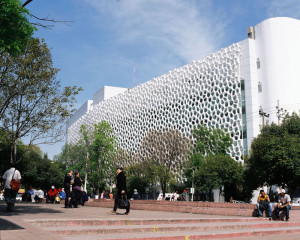Source: vice.com
Published: March 29, 2013
Mexico City is the latest to show off a building that sucks up pollution.

Behold: The great smog-gobbling hospital of Mexico City, also known as the Torre de Especialidadesis
We’ve seen some pretty sick smog situations around the world this year. Beijing saw its pollution problem spike to record levels and spent weeks blanketed in a poisonous brown cloud. Meanwhile, some unfortunate weather patterns spawned even more serious pollution problems in Iran, notably in the city of Ahvaz where the air is three times worse than in Beijing.
Cutting down on traffic with road space rationing techniques can only do so much, and as public health concerns become more pressing, officials and environmentalists alike are scrambling for new solutions. How about building a bunch of smog-gobbling buildings?
It’s not that hard. The technology for smog-eating buildings is here. First demonstrated by Alcoa, it combines basic chemistry with smart construction to create façades that can digest polluted air and effectively erase the effects of thousands of cars on the road. The best part about the technology is that you wouldn’t even know it’s there.
It’s effectively a coating that can be applied to aluminum and other building materials. Naturally, architects have been experimenting with this stuff and even innovating, coming up with more efficient and effective designs. As a result, smog-eating buildings are starting to pop up around the world, and they’re spectacular.
Mexico City is the latest to show off a building that sucks up pollution. Dubbed the Torre de Especialidadesis, this hospital takes advantage of a new tile made by the Berlin-based company Elegant Embellishments called proSolve37e. The tiles are based on the same kind of technology that Alcoa unveiled a couple of years ago, except the resultant façades are much prettier and the effects are more powerful.
The basic idea behind this smog-eating technology is organic chemistry at its finest. Simply speaking, a titanium dioxide coating on the building materials creates a chemical reaction when it comes into contact with ultraviolet rays and pollutants in the air.
As Forbes environment editor Todd Woody explains, “electrons in the titanium dioxide become supercharged and interact water molecules in the air … [releasing] free radicals that break down organic material on the building panel and pollutants such as nitrogen oxide in the surrounding atmosphere.” So the tiles clean themselves while converting pollution into harmless compounds. Meanwhile, the titanium oxide coating remains unaffected, ready to zap some more smog.
That’s crazy, but it gets crazier. The particular mesh-like design of the façade on the Torre de Especialidadesis maximizes surface area, boosting the tiles’ pollution equalizing effects. The shape of the tiles themselves “create omni-directionality, and surface enlargement, which enhances their ability to receive and scatter UV light,” Elegant Embellishments founder Allison Dring explains. “The shapes slow wind speeds and create turbulence, for better distribution of pollutants across the active surfaces.
In other words, the tiles effective suck the smog into their death grip, cleaning the equivalent of the pollution created by 8,750 cars each day. And, once again, look really pretty in the process.
So why doesn’t every building have these magic, smog-gobbling tiles? Simple math suggests that a dozen the size of Mexico City’s awesome new hospital would equalize the air created by 100,000 cars daily — at least in theory. The only downside to this technology is that it’s still pretty new, so it’s unclear how it’ll hold up over time. Of course, if the titanium dioxide starts slacking off, you could always slap a fresh coat of the stuff or a new set of tiles on the façade.
This stuff isn’t cheap, either. It’s an additional expense for builders, but it’s not that bad. For instance, Alcoa’s product, Reynobond with EcoClean, would only add a 4- to 5-percent premium to the cost of construction. Meanwhile, the self-cleaning properties of the coating would cut cleaning costs by as much as two-thirds, the company says. It pays for itself!
Want a smog-eating building in your neighborhood? Tell your friends and raise some money. Like, a lot of friends and a lot of money.”
